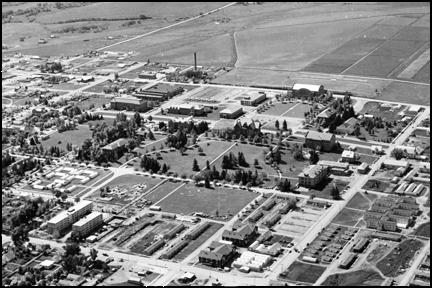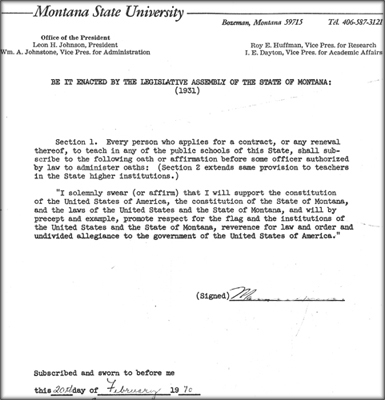Annals of MSC: 1944-1963
Note3
Roland R. Renne (President: 1943-1964), Head of the Department of Agricultural Economics at MSC, became acting president for one year and was named MSC President in 1944. His attention to wartime programs led to a delay for inaugural ceremonies until April 1945. He regarded the College as “overly technical and excessively narrow.” The time had come, he said, for “a more realistic appreciation of the values of the humanistic-social science subjects and the improvements of all our services in the interests of serving the general welfare.” The historian Burlingame observed that “with these words, Renne laid the groundwork for the projection of Montana State College into Montana State University.”6
The end of WWII allowed young people, whose normal lives had been delayed by national service, to get back to their schooling. The demands of war had uncovered the necessity of a workforce trained in subjects that were historically emphasized at MSC and the college began rapid growth. The 1944 enrollment of 1155 grew to 5250 students in 1964, with intermediate counts of 3664 students in 1947, 2400 in 1950, and 4438 in 1960. The number of faculty grew from 132 in 1944 to 389 in 1964. There was a short period of enrollment decline in the early 1950s after the first wave of veterans completed their studies. By the mid-1960s, a demographic surge of baby-boomers arrived on U.S. campuses.9
Many of these students were attracted to MSC for training in science and engineering because the sciences, both theoretical and applied, were MSC’s primary focus from its beginning. The returnees boosted enrollments and bolstered demands for a larger faculty and new facilities. Support for research was becoming available; “the war generated an enormous amount of scientific research ... the mix of state and federal funding changed dramatically ... with federal agencies becoming increasingly central to the kind and quality of science practiced on the campus.”12
To accommodate the post-war students and to provide classroom and research space, Renne purchased and brought to the campus temporary buildings no longer needed by federal installations. Among the imported structures were large frame buildings that could be shared by a variety of disciplines, 125 house trailers for housing, prefab wooden-frame buildings for single- or double-family occupancy, many Quonset huts, and one large barracks that could house almost 400 students. A significant portion of those temporary building were still in use 30 years later. In the right-foreground and the left-hand side of the 1954 photo (below), the war surplus buildings are seen to be an important component of the campus.

Aerial view of MSC from the NW 1954
The 1950s brought new construction to the campus. The Math-Physics Building (1952, now A. J. M. Johnson Hall), an addition to Linfield Hall, a veterinary science building, new greenhouses, an addition to the Ryon Engineering Laboratories, and a service shop were the first structures built. The Student Union Building received a large addition. In the late 1950s, funding was secured for Reid Hall, a new dairy center, a medical science research building (Cooley Labs), and new dormitories including Langford, Culbertson, and Mullan Halls. The Brick Breeden Fieldhouse was completed in 1958; at that time it was the premiere college basketball and all-purpose facility in the Northwest. In 1957, the Museum of the Rockies opened in a former dairy barn.
The 1939-41 MSC Catalog listed student expenses. The estimated total college academic year expenses for a student in 1940 were $485 ($8,490 in 2017 dollars). During the next 10 years, the expenses increased less than the prevailing inflation rate; total college academic year expenses for a student in 1950 were $800 ($8,140 in 2017 dollars) for a Montana resident and $875 ($8,900 in 2017 dollars) for a non-resident. However, during the 1950s the extra-tuition for non-resident students steadily increased. The total college academic year expenses for a student in 1960 were $1,073 ($8,890 in 2017 dollars) for a Montana resident and $1,335 ($11,060 in 2017 dollars) for a non-resident.

Marty Hamilton's loyalty oath, required as a condition of employment at MSU in 1970
A loyalty oath was a requirement for public school educators in Montana since 1931. We (Dick Lund and Marty Hamilton) both had voluntarily performed uniformed service hitches, but still had to sign the loyalty oath as a condition of employment (see the photo of Marty Hamilton's signed oath). At that time, about half the states required a loyalty oath. Montana’s oath requirement faded away in the 1970s as it did throughout the country.15
Administration of the Montana University System was ill-defined after the MUS chancellorship was phased out in 1950. MSC President Renne was the senior member of the universities’ Presidents Council and he took the lead in representing all six units. During the 1950s, he was able to secure considerable support for the system generally, and for MSC specifically.18 Because of Renne’s MSC successes, the rivalry between MSC and the university in Missoula became intense, and evolved into academic infighting that was politically counterproductive.
The Montana Legislative Council and the Governor’s Committee on Education Beyond the High School commissioned an independent study of the administration of higher education in Montana. The report of that study was published in 1958. The author was G. Homer Durham, Vice President, University of Utah.21 In his introduction, Durham writes,
“Where belief in the efficacy of sound knowledge exists, in the necessity for the unceasing search for truth, there a university may flourish and spread its benefits. Where such belief is weak or falters, a university tends to decay.”
The Durham Report includes 50 pages of data in tables and charts. Across the 6 units that made up the University of Montana System in Academic Year 1957-58, MSC’s enrollment of 3561 (87.2% from Montana) was by far the largest. MSC taught approximately 44% of the system-wide total student credit hours. The MSC student-to-faculty ratio of 15.8 was higher than all units except Eastern. Durham noted that MSC was markedly efficient, especially so because it was “the largest and most complex institution of the system.”24 The MSC annual tuition and fees in 1957 were $221 ($1880 in 2017 dollars) per resident student and $371 ($3150 in 2017 dollars) per non-resident student.
The monetary efficiency of MSC described in the previous paragraph put undue pressure on the faculty, who let the administration know its serious concerns about MSC employment. In the 1950s, salaries were below the peer average for the Northern Plains and Rockies. There was no satisfactory health insurance program or sick leave policy. Retirement benefits were subpar, and sabbatical leaves were nonexistent. Social security had not been adopted by the MSC administration, despite the passage of the act in 1935. Teaching loads were high. Faculty were burdened by a housing shortage in Bozeman.27 Some of these issues would be solved in time but others would not, and probably will remain unresolved. In fact, the faculty shortly would face even worse times.
Renne’s successes and liberal views had rankled the conservative state legislature and the Republican Party in general. The GOP nominated the very conservative Donald G. Nutter to run for Governor in the 1960 election. Renne intensively labored against Nutter’s candidacy. But Nutter was elected and he wasted no time penalizing Renne by announcing in his inaugural address that MSC was overstaffed and he will demand a significant reduction in personnel. The Nutter administration set out to cut state expenditures for state services, especially those for education, with MSC getting special attention. Nutter and his budget director took over all the management of higher education, leaving out the Board of Education. He convinced the legislature to penalize unit administrators if they attempted to make up for lost revenues by increasing their enrollments through expanded recruitment. He put a moratorium on university system construction projects. He cut the MSC budget by an amount between $1.1 million and $1.5 million including cutting the research budget completely out of some programs and significantly reducing the budgets for the MAES and Cooperative Extension Service. There were more than 4000 students at MSC in 1961. Student representatives complained, but Nutter remarked that he was planning another budget cut for 1963. The assault on education diminished suddenly in January 1962 when Nutter died in a tragic airplane accident. The Nutter administration and the 1961 legislature created possibly the bleakest moment for higher education in Montana!30
Lieutenant Governor Tim Babcock took over and prepared to be elected governor in 1964. Renne took a leave of absence in February, 1963, for a temporary assignment in President J. F. Kennedy's administration. After Kennedy was assassinated in the fall of that year, the Democratic Party asked Renne to come back to Montana and run against Babcock. On February 15, 1964, Roland Renne resigned as president of MSC and declared himself a candidate for the governorship. The next day, Dr. Leon H. Johnson was appointed President of MSC. He had been the acting president during Renne’s leave of absence. That is an appropriate event for ending this era of war, academic growth, and political headwinds at MSC.33
Annals of MSU during Era 5
Next topic (National Events) in Era 4
Table of Contents
Last Revised: 2021-04-18
